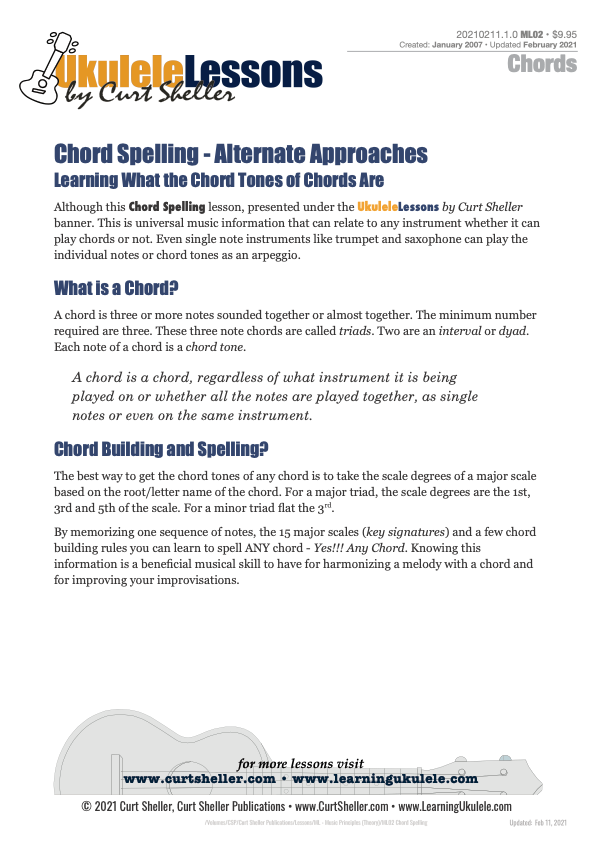An alternate approach to determining the chord tones of any chord. Bottom-line is, it's the notes that make the chord, not the shape. A C chord is C, E, G - NOT this or that shape.
















The quickest and most directly way to determine the chord tones of any chord are to use the scale degrees of its corresponding major scale.
Available for Premium Site Access Plans Only
For a major triad, the chord tones are the 1st, 3rd and 5th scale degrees of a major scale starting on the root of the chord you're using to determine the chord tones. For a minor triad, you simply flat the 3rd.
A C or C major chord the 1st, 3rd, and 5th of the C major scale (C D E F G A B C) are the C, E, and G. For C minor (Cm) it's C, Eb, and G.
By memorizing one sequence of notes, your major scales and a few chord building rules we can learn the notes, to spell ANY chord.
Traditional Chord Spelling/Building Approach
The traditional approach, which is the way to go, is to learn the notes of individual chords based from the major scale of the root of the chord. For Cm11 the root is C, so the major scale is C major. For Bb7 the root is Bb and the major scale is Bb major.
By memorizing one sequence of notes, the major scales, i.e., key signatures) and a few chord building rules you can learn to spell ANY chord. The directions are actually built into the chord's name. This is a beneficial skill to have for harmonizing a melody with a chord and for improving your improvisations.

The quickest and most directly way to determine the chord tones of any chord are to use the scale degrees of its corresponding major scale.
Available for Premium Site Access Plans Only
For a major triad, the chord tones are the 1st, 3rd and 5th scale degrees of a major scale starting on the root of the chord you're using to determine the chord tones. For a minor triad, you simply flat the 3rd.
A C or C major chord the 1st, 3rd, and 5th of the C major scale (C D E F G A B C) are the C, E, and G. For C minor (Cm) it's C, Eb, and G.
By memorizing one sequence of notes, your major scales and a few chord building rules we can learn the notes, to spell ANY chord.
Traditional Chord Spelling/Building Approach
The traditional approach, which is the way to go, is to learn the notes of individual chords based from the major scale of the root of the chord. For Cm11 the root is C, so the major scale is C major. For Bb7 the root is Bb and the major scale is Bb major.
By memorizing one sequence of notes, the major scales, i.e., key signatures) and a few chord building rules you can learn to spell ANY chord. The directions are actually built into the chord's name. This is a beneficial skill to have for harmonizing a melody with a chord and for improving your improvisations.

Chord Spelling - An Alternate Approach


FACE and Every Good Boy Does Fine

You finally get to put you elementary school music class to practical use.
If you remember the names of the lines and spaces of the music staff you can spell any chord with a few of the tools in this lesson.
Related Lessons, Videos, Lesson Series, Songs, Books & Reference Charts, Resources & Assets, Workshops are below.

The Big Six Core Chords is a series of lessons for building your core, essential 4-part chords. These chords commonly called jazz chords, are really just 4-part chords used in a wide range of musical styles. These chords include: Seventh , Major Seventh, Minor Seventh, Half Diminished Seventh or Minor Seven Flat Five, Diminished Seventh, and Augmented Seventh. These six chords form a core set of chords.

Harmonic Analysis is the understanding of the functional sequence of chords. It is the process used to analyze the harmonic structure of a progression, song or composition. This analysis is then used to make scale selections for improvisation and chord substitution.


return in your investment)—it is this— learning the
f*ckingnotes of your OWN instrument. Sorry for the tough talks—but it is sooooo true!


Learn to read single note melodies in the first/open position is a lot easier than you might think. Book: Ukulele – Reading Music Series – Primer

An organized collection of daily practice and reference material for the contemporary ukulele player for developing the vocabulary and knowledge necessary for single note playing. Book: Daily Practice Material for the Contemporary Ukulele
Checkout the Books & Reference Charts for additional Handy, Dandy Reference Charts.

Ukulele Fingerboard Chart for C Tuning, Low or High G – G C E A

Ukulele Fingerboard Chart for G Tuning, Low or High A – D G B E

A handy reference chart of all 15 major and relative minor key signatures. US Letter 8.5 x 11 sized (ANSI-A) , A4





.jpg)